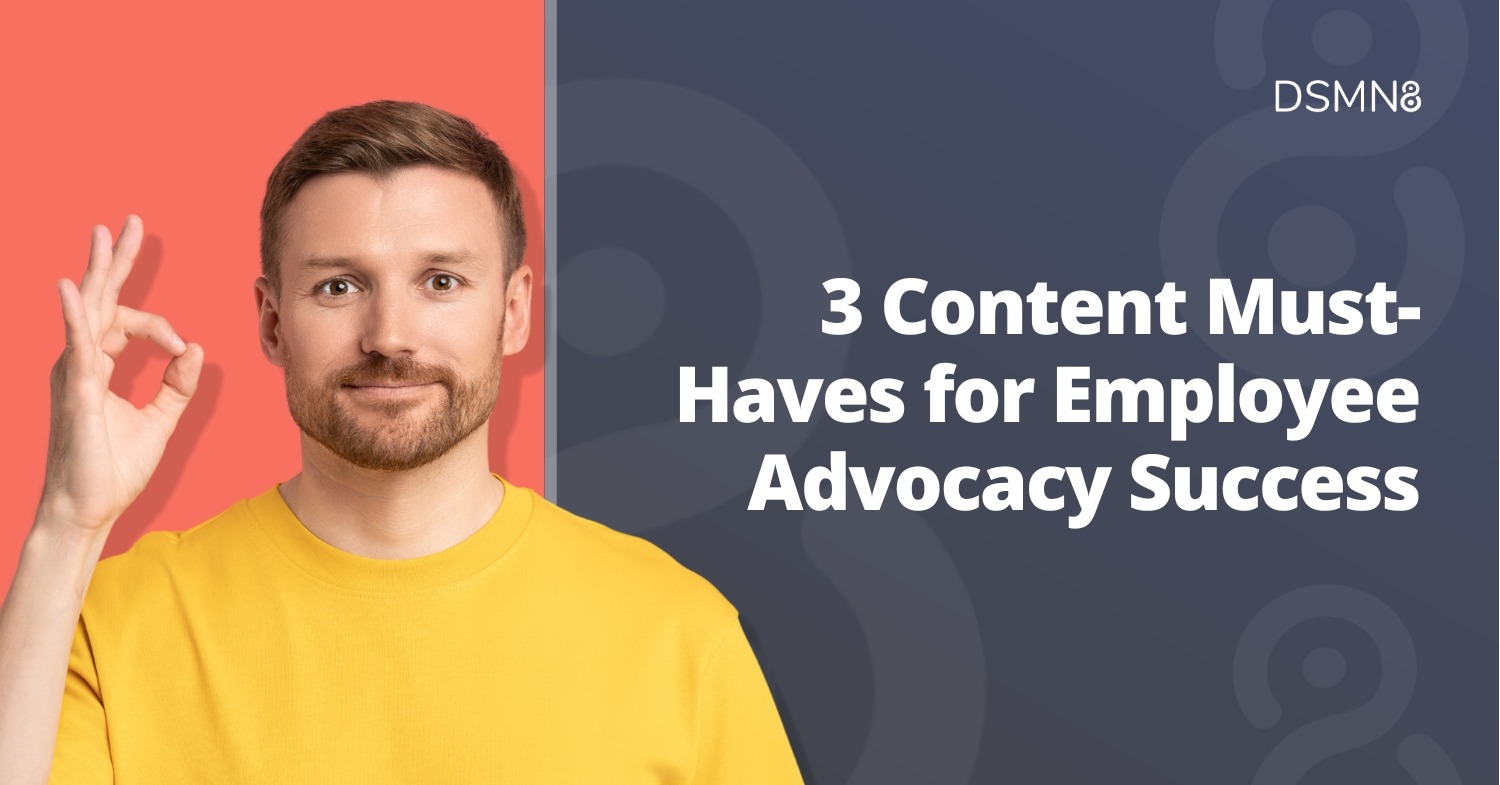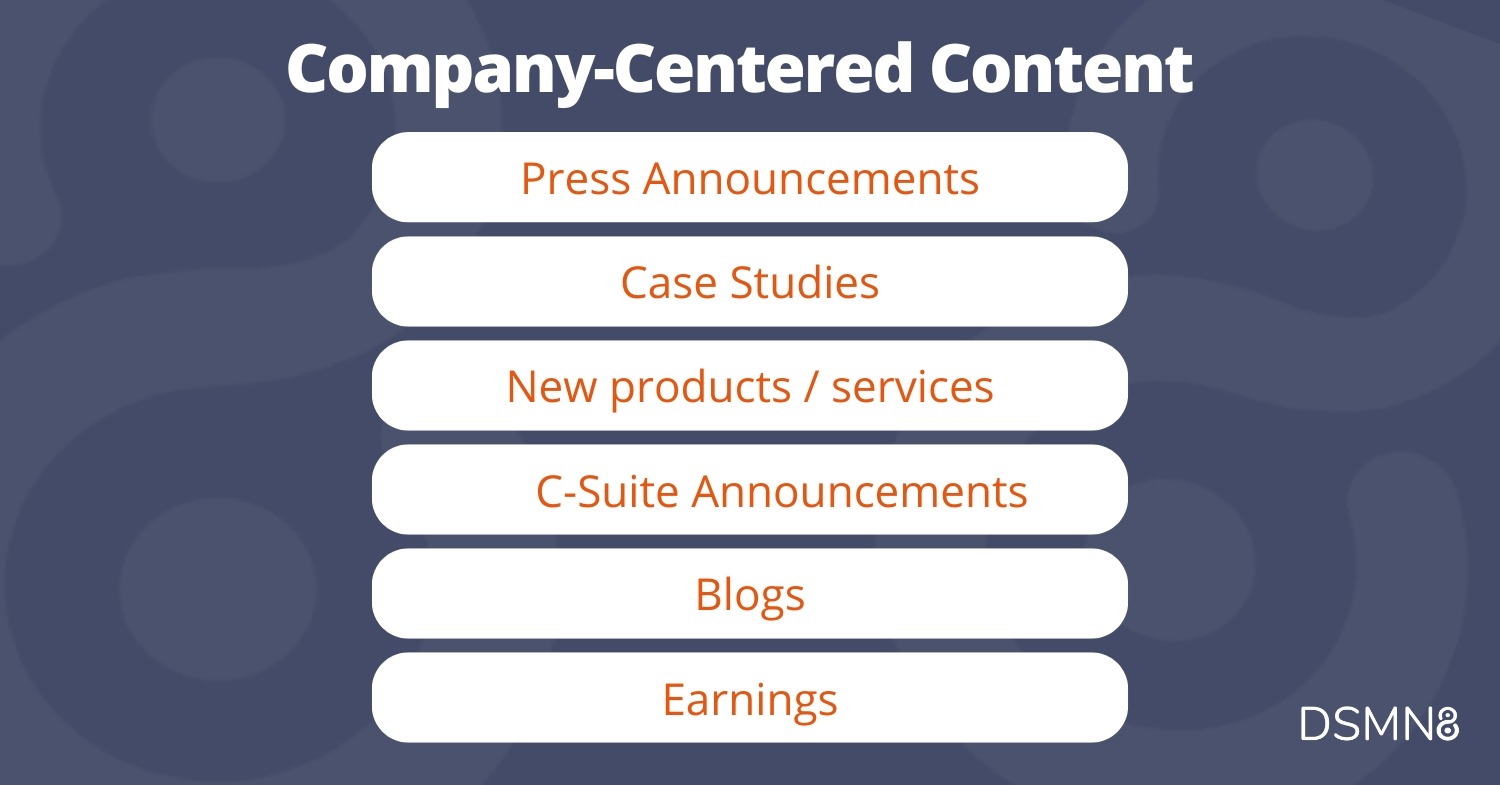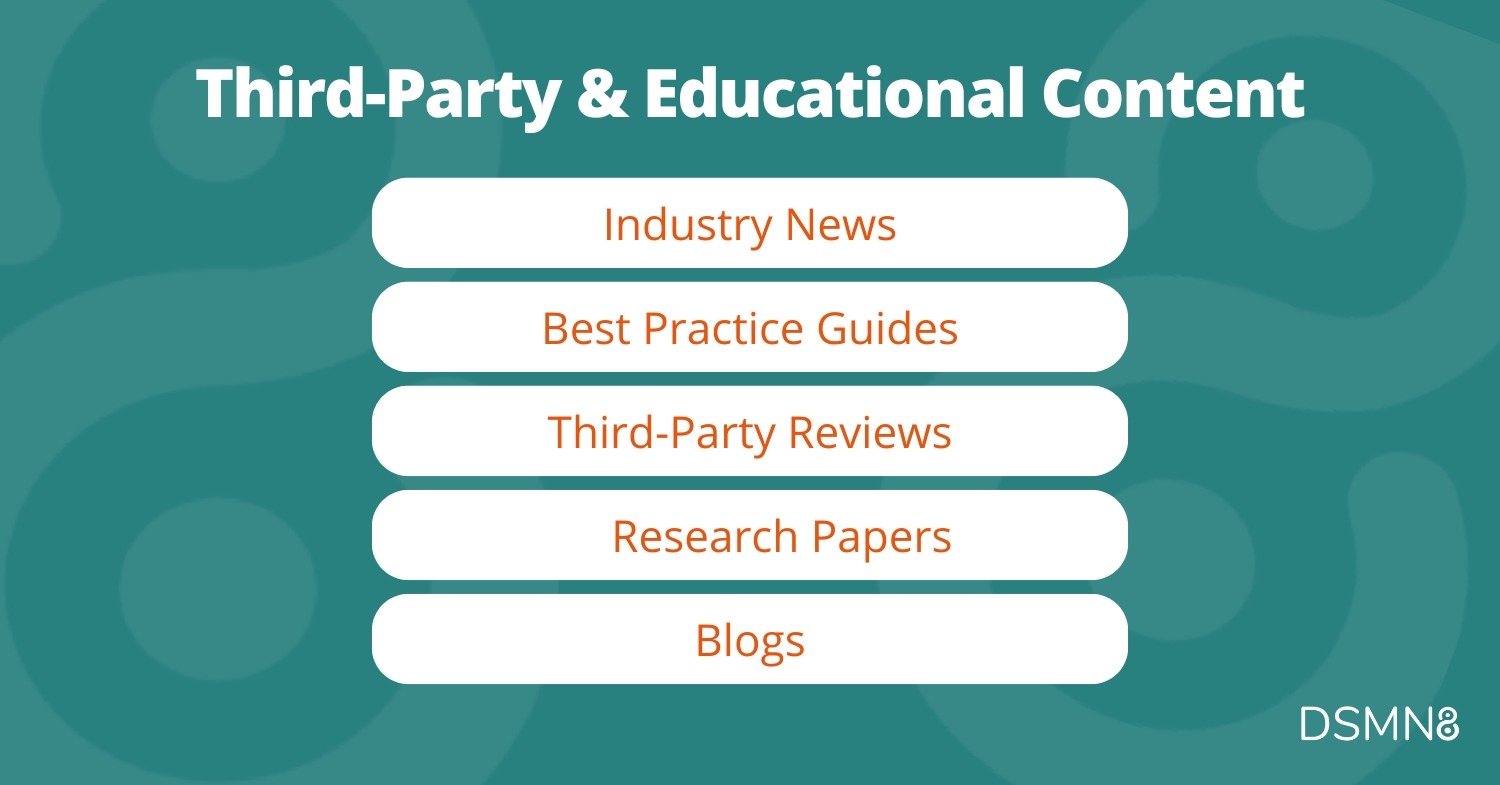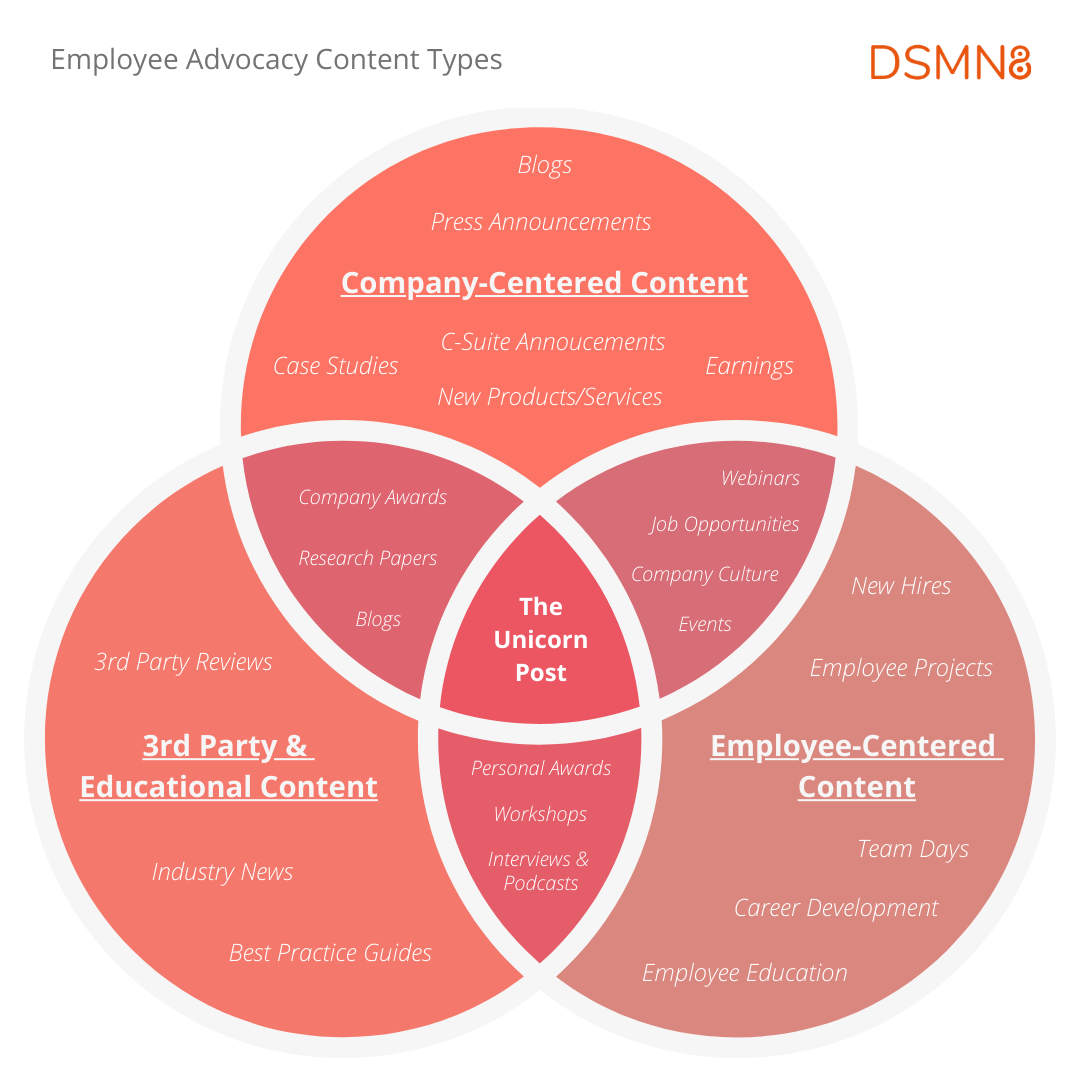
An advocacy program is nothing without content.
Here at DSMN8, we believe three main types of content should be a part of your advocacy program.
Different types of content have different goals and varying levels of effectiveness. This can range from how engaging the content might be when shared by an employee to how likely employees are to share the content with their networks.
There is no perfect formula for your advocacy content strategy; every company is different, with different types of content available.
Some will regularly have reviews, press coverage, and third-party articles available, and others may have a wealth of research papers and case studies.
Starting an employee advocacy program may reveal that your company needs to be doing more to increase its content output.
Finding the content strategy that works for you will become evident quickly. Using reports and analytics in DSMN8 or another employee advocacy platform will allow you to understand what content proves most effective for your employees and your brand.
Your company may be launching an advocacy program for several reasons, and defining your objectives will undoubtedly influence your content decisions.
Whether you are trying to drive website traffic, increase brand awareness, highlight your company culture, or simply encourage your employees to have more of a voice on social media, there will be a content strategy for you.
We believe that employee advocacy content can be divided into three main categories:
- Company-Centered Content
- 3rd-Party & Educational Content
- Employee-Centered Content.

Company-Centered Content
Company-centered content will usually make up the majority of the content shared in an advocacy program. This is because it is often the most readily available content organizations produce.
Put simply, company-centered content is an article, blog post, or even website page that, if shared and engaged with, will ultimately benefit the company.
These typically come in the form of press announcements, such as acquisitions or C-suite announcements, but they can also focus on new products and services. This content has direct value for the company.
While this content is beneficial for the company, it is not necessarily the most authentic for employees to share. When shared, it proves useful for the company but provides less value for employees unless they were personally involved in what happened.
With this in mind, company-centered content will be most effectively shared by senior leadership, PR/comms teams, and the HR, as the news will be more relevant to them.
For example, sharing an earnings report on LinkedIn as a CEO or senior director would be an effective and customary act that would generate attention and interest from their network.
However, if a Junior Account Executive were to share an earnings report on LinkedIn, it may look out of place and not directly relevant to their network.
Senior Leadership, PR Teams, C-Suite

Third-Party & Educational Content
Educational and third-party content is, in many ways, the most valuable material in your advocacy arsenal, but it is also usually the least available.
Company-centered announcements and employee-centered content generally come from an internal source and directly benefit the company.
Third-party and educational content has a different purpose: to gain the trust of readers and establish the sharer as an industry expert and thought leader.
Reviews and news articles about your company, products, or services from a third-party source will naturally be more authentic and garner a different type of attention.
The focus has been drawn away from something the marketing department has pushed out and is now an independent piece of news.
This is a very effective form of content to share through your advocacy program. We notice across the majority of our clients that third-party content will perform significantly better than company-owned content.
However, many companies have limited control over this type of content, and if you are not mentioned often in news articles, it can be difficult to source. An alternative can be educational content, such as best practice guides or industry news articles that are relevant to your company’s offerings.
The purpose of this type of content is not to directly promote your company but to help educate those who will be reading employee posts on social media. If you can do both, then great!
Naturally, people are distrustful of company-owned content in the same way we are wary of advertising. Third-party and educational content helps build a digital rapport with readers.
If you are regularly sharing content with your LinkedIn network, you need to provide value to your audience. Share content they will be inclined to read even if they have no immediate interest in your company, product, or service.
Building this trust is imperative for social selling. Allowing your network to warm to the idea of your expertise and services will result in conversations and contact with prospective customers and clients.
Sales, Marketing, Support/Service Teams

Employee-Centered Content
Employee-centered content (EGC) is the third pillar of an advocacy program.
Let’s return to the main goals of an advocacy program: increasing brand awareness, generating website traffic and leads, and amplifying the reach of marketing content.
But beyond that, employee advocacy programs are a great way to bring your company together and develop a more profound sense of company culture.
Employee-centered content can do just this.
Everything from employee projects and team away days to employee awards content is focused on helping employees develop their personal brands on social media.
Having employee-centered content is vital to encouraging employees to join your program. We’ve found it’s a big driver of user adoption compared to programs that solely share company content.
It allows employees to share content that is less “work-focused” and more about the company’s culture.
This has the knock-on effect of increasing the transparency of your company, lifting the lid on what it’s like to work there. Acting as a porthole for your company culture, advocacy will have significant effects on hiring, with more referrals from people interested in working with you and less requirement to spend on recruiters.
Large enterprise companies can often feel fragmented. This sort of content can also be educational to the employees, letting them catch up on recent news, projects, and events. It helps employees feel more a part of the company itself rather than just the department or building they work in.
Keep in mind that your employee-centered content doesn’t always have to be externally shareable.
The DSMN8 platform can be used to share internal posts for internal eyes only. Acting as an employee communications tool, news and updates can be published to help educate and provide new information to employees.
HR, Marketing, New Hires, Graduates

Content for an employee advocacy program is never as simple as it is laid out here, and there is no right or wrong amount to add to your platform.
Our benchmark report revealed that while some organizations provide up to 10 pieces of content per week, some only provide 1 or 2. The larger your program grows, the more demand there’ll likely be for fresh content.
The most important component is having a mix of content types. This provides employees with the ability to cherry-pick what they feel is most appropriate and relevant for their networks and personal brands.
The result is that employees will grow into influencers for your brand in a way that isn’t forced, giving them and your company the most value at every opportunity.
For more insights on using this to inform your employee advocacy content strategy, check out the podcast episode below:
Check out The Ultimate Guide to Employee Influencers to learn more about how to turn your employees into full-blown influencers.
It covers everything from trends driving the demand for employee influencers to an all-encompassing business case. You’ll also find insights from industry leaders, infographics, and checklists for success.
Ready for an Employee Advocacy Platform? Book a Demo!
DSMN8
The All-in-One Employee Advocacy Platform.



